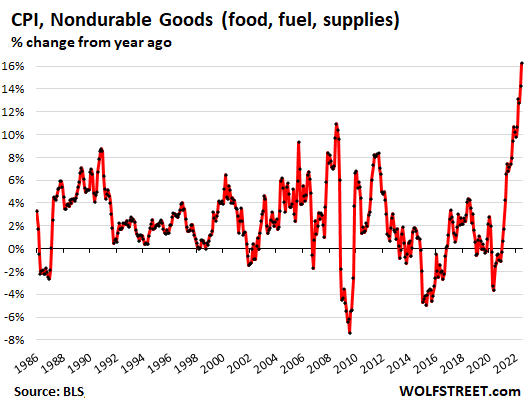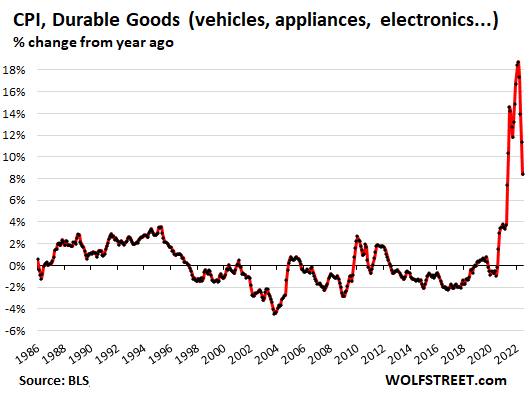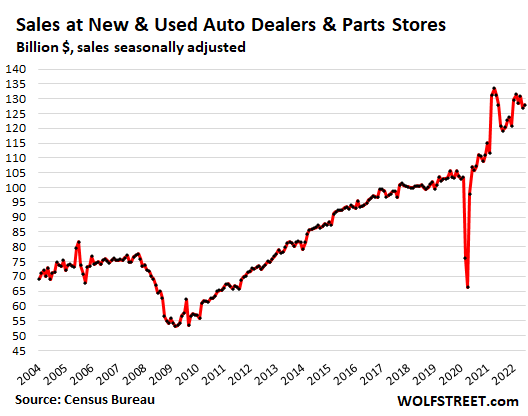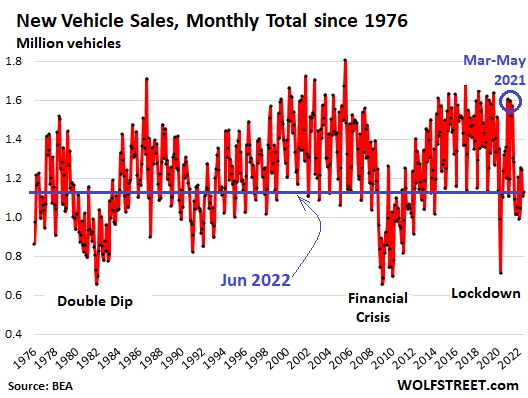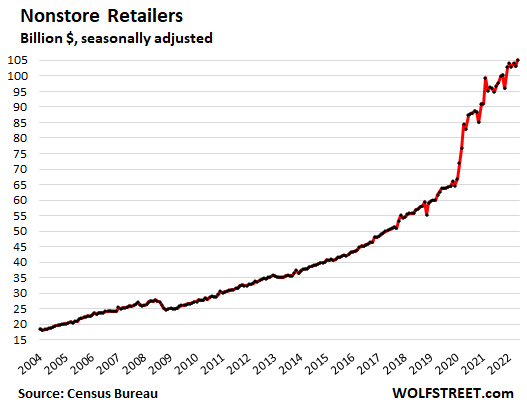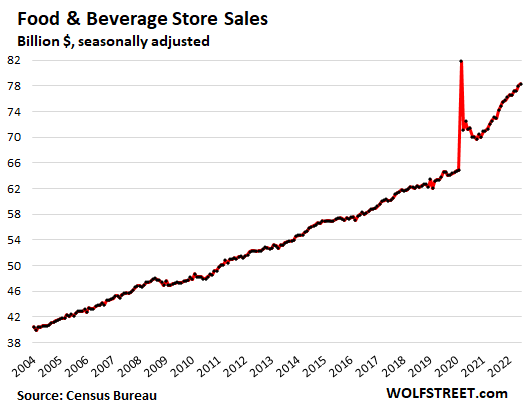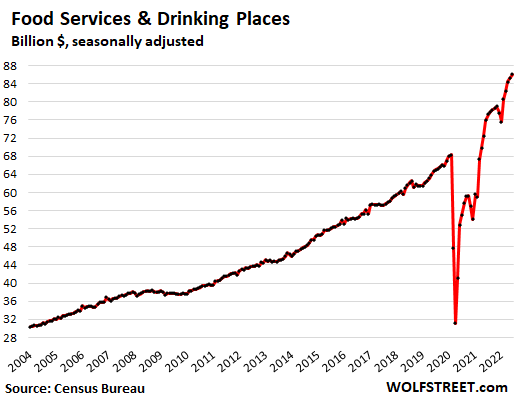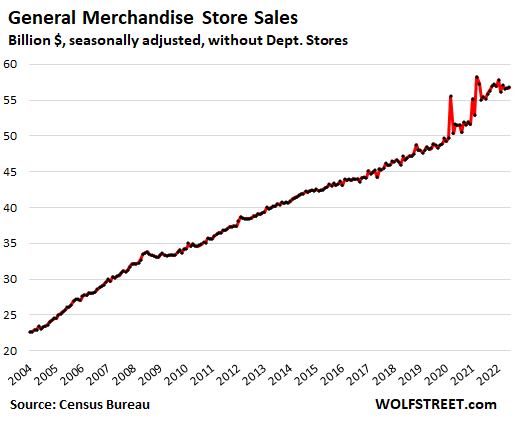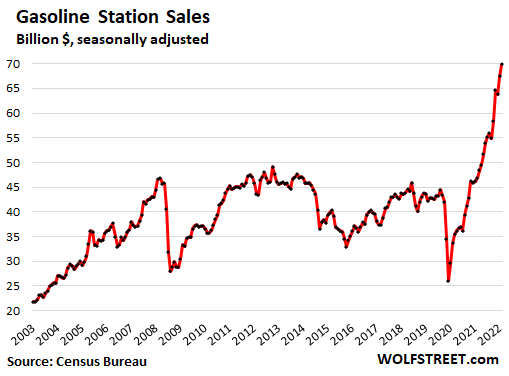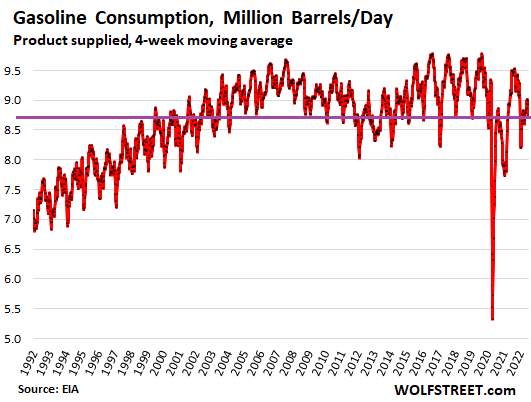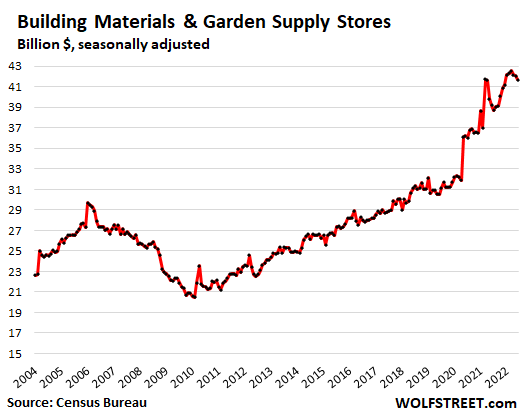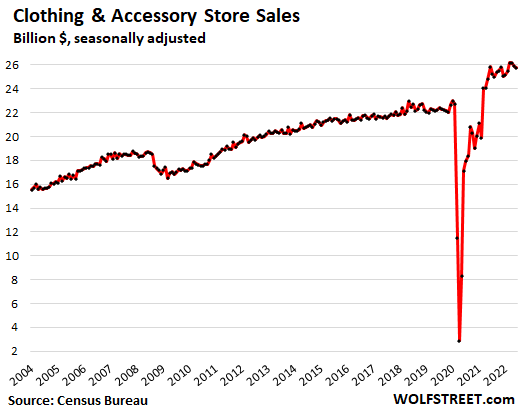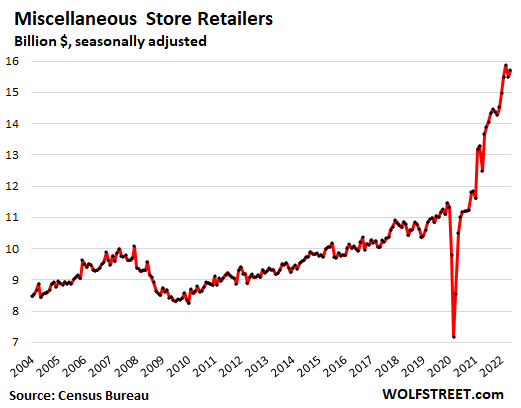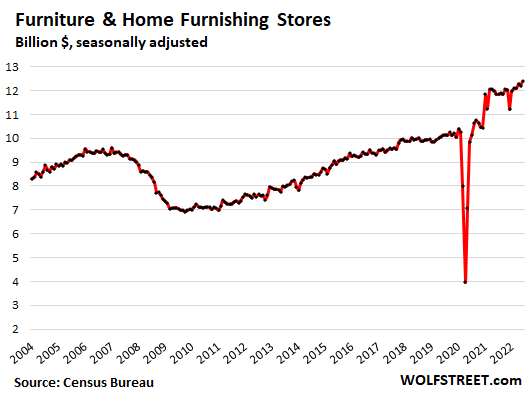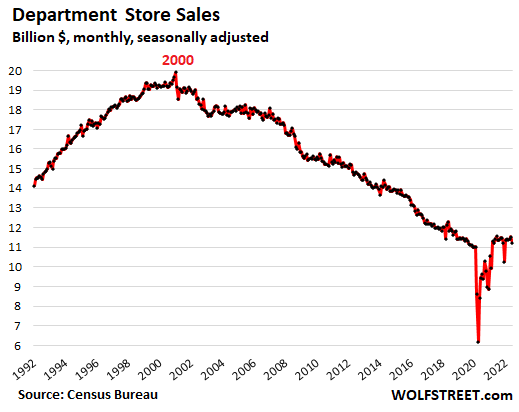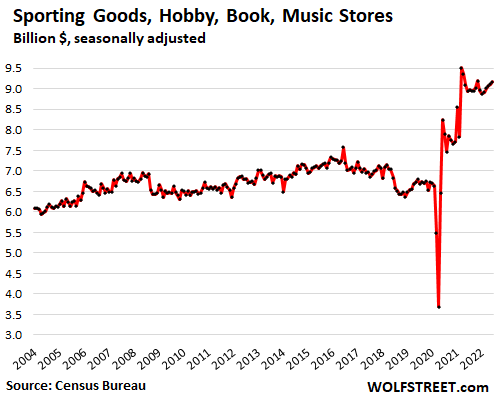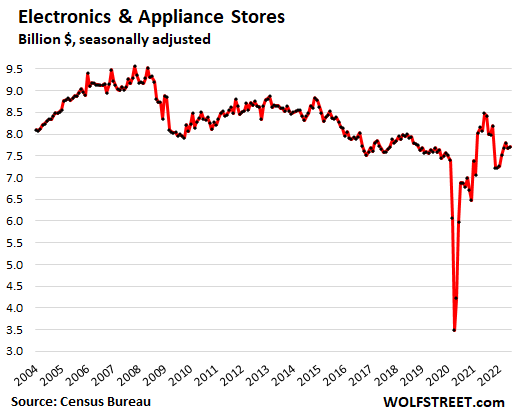But inflation is eating everyone’s lunch.
By Wolf Richter for WOLF STREET.
Retail sales in June jumped by 1.0% from May, and by 8.4% from a year ago, and by 32.5% from June 2019, to $681 billion, seasonally adjusted, the Census Bureau reported today.
Retail sales are sales of goods. Sales of services, such as insurance, healthcare, airline tickets, etc., are not included in retail sales. Ticket sales at the multiplex in the mall are not included in retail sales, but are services, and consumers have been shifting some spending back to services. And yet, consumers still splurged on goods. These folks are tough, when it comes to shopping. Nothing appears to be able to knock them down – not even the raging inflation.
Inflation rages in services, food, gasoline; recedes in durable goods.
Inflation is ricocheting around the economy. Where prices are now spiking are in services – but they’re not included in retail sales.
And prices are spiking in nondurable goods, dominated by food, gasoline, and supplies. These nondurable goods are sold at various categories of retailers, such as grocery stores, gas stations, general merchandise stores that sell food, supplies, and gasoline, at some “miscellaneous stores,” such as cannabis stores. But wait… cannabis products are not in the CPI basket.
But in durable goods, crazy-raging inflation of nearly 19% early this year has been abating and in June down to 8.4%. Retailers in that categories are stores that sell motor vehicles, auto parts, appliances, tools, electronics, furniture, etc.
Sales by category of retailer, not adjusted for inflation.
Sales at New and Used Vehicle and Parts Dealers, the largest category of retail sales, rose by 0.8% in June from May, to $128 billion, seasonally adjusted, and were unchanged from a year ago, but up 24% from June 2019, amid huge price increases in 2021 that are now flattening out. There was plenty of supply in used vehicles. But many new vehicle dealers were still woefully short on inventory, and consumers who want to purchase a vehicle are having to order it and wait for months.
But unit sales are way down from a year ago for both new and used vehicles. The number of new vehicles delivered to end users in June plunged by 13.5% from the beaten-down June 2021, to 1.13 million vehicles, and by 25% from June 2019.
The number of used vehicles delivered to retail customers in June fell by 13% year-over-year, according to Cox Automotive, as consumers are starting to rebel against the ridiculous price spike last year, and those price spikes have hit buyers’ resistance.
Sales at ecommerce and other “nonstore retailers,” the second largest category of retail sales, jumped by 2.2% in June from May, to a record $105 billion, and were up 9.6% year-over-year and up by 68% from June 2019. This includes the ecommerce operations of brick-and-mortar retailers, along with sales at stalls and markets. The ecommerce boom continues:
Food and Beverage Stores: Sales rose by 0.4% for the month, and by 7.1% year-over-year, to $78 billion. Compared to June 2019, sales were up by 23%:
Food services and drinking places: Sales at bars, restaurants, cafes, cafeterias, etc. jumped by 1.0% for the month, and by 13.4% year-over-year, to a record $86 billion. They’re in a boom, with sales up 33% from June 2019. Note that the year-over-year sales increase of 13.4% far outran the CPI for “food away from home” (7.7%). Americans are going out with a vengeance and are flocking to restaurants.
General merchandise stores: Sales ticked up 0.3% for the month, and by 2.4% from the stimulus-miracle last year, to $57 billion. Walmart and Costco are in this category, but not department stores. Compared to June 2019, sales are up by 18%:
Gas stations: Sales jumped by 3.6% for the month, and by 49% year-over-year, to $70 billion, on spiking gasoline prices, even while actual consumption, measured in volume, has dropped, as consumers are responding with changes in their driving patterns to cut fuel consumption and put a lid on their gasoline expenditures.
Actual gasoline consumption, in barrels per day, hadn’t gone anywhere since 2007. And now the price spikes have triggered a buyers’ strike. In the week through July 8, gasoline consumption plunged to 8.73 million barrels per day (four-week moving average), according to EIA data, a level first seen in July 1999
Building materials, garden supply and equipment stores: Sales fell by 0.9% for the month to $42 billion, but were still up by 6.4% from the stimulus miracle last year:
Clothing and accessory stores: Sales dipped 0.4% for the month and were flat year-over-year. At $26 billion, they were still up by 16% from June 2019:
Miscellaneous store retailers (includes cannabis stores): Sales jumped by 1.4% for the month, and by 15.1% year-over-year, to $15.7 billion. Compared to June 2019, sales were up 43%! This category tracks specialty stores, such as arts supplies stores, brewing supplies stores, and cannabis stores – now the hottest category in brick-and-mortar retail:
Furniture and home furnishing stores: Sales rose 1.4% for the month, and by 4.6% year-over-year, to $12 billion, and were up 22% from June 2019:
Department stores: sales fell 2.6% for the month, and by 2.9% year-over-year, to $11 billion. Compared to the peak in the year 2000, sales were down 44%, after numerous department store chains were liquidated in bankruptcy courts, and thousands of stores closed, and the surviving department store chains are still closing stores.
This chart, which goes back to 1992, shows the slow and methodical demise of what once was the quintessential way of shopping for Americans:
Sporting goods, hobby, book and music stores: Sales rose 0.8% for the month, and 2.7% year-over-year, to $9.2 billion, up 35% from June 2019:
Electronics and appliance stores: Sales ticked up 0.4% for the month, but were down 9.1% from the stimulus miracle a year ago. At $7.7 billion, sales were up just a tad from June 2019.
This segment covers only specialty electronics and appliance stores, such as Best Buy or Apple stores, not any of the other stores, such has Walmart, and ecommerce sites, where the vast majority of these goods are sold.
Enjoy reading WOLF STREET and want to support it? Using ad blockers – I totally get why – but want to support the site? You can donate. I appreciate it immensely. Click on the beer and iced-tea mug to find out how:
Would you like to be notified via email when WOLF STREET publishes a new article? Sign up here.
